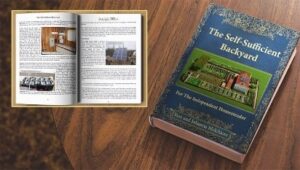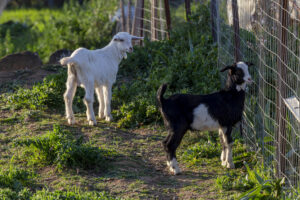Introduction
Homesteading has a rich history, and numerous benefits, and is something anyone can do no matter where they live. In this article, I will explain what homesteading is, discuss the benefits of it, highlight the various types, and provide tips on how to get started.
Homesteading is essentially a lifestyle choice that seeks to reduce one’s reliance on corporate production and consumption of goods. It can involve becoming self-sufficient in growing and preserving food, generating energy, building homes and other structures, and even producing clothing or other consumer items. Homesteading dates back to the Homestead Act of 1862, which offered citizens up to 160 acres of free land in exchange for five years of continuous residence on the property. I wish they still did that where I live!
Homesteading can offer numerous benefits. On a financial level, it can help reduce costs associated with food and energy by providing alternative ways of producing them at home. Health-wise, growing your food can provide access to fresh, organic produce which is often more expensive at the grocery store. It can be very satisfying to eat food grown by your own hands fully knowing it is pesticide free. Finally, homesteading has numerous environmental benefits from saving on gas used in cross-country corporate delivery systems to decreasing landfill volume by composting.
Types of Homesteading
A. Urban Homesteading
Urban homesteading is an increasingly popular lifestyle choice for those who wish to live sustainably and self-sufficiently in the city. It involves using limited space and resources to produce one’s own food, energy, goods, and services within an urban context. It may involve community gardens, greenhouses, balcony gardening, and rooftop gardens.
B. Suburban Homesteading
Suburban homesteading is a more traditional form of homesteading that utilizes the backyard space and natural resources available in suburban neighborhoods to live a sustainable lifestyle. This includes growing vegetables, raising farm animals such as backyard chickens and rabbits, utilizing renewable energy sources such as solar power or hydropower, composting to reduce waste, and water conservation such as rain barrels.
C. Rural Homesteading
Rural homesteading is the most common form of homesteading. It involves living in more remote areas of the country, away from cities and towns, to live a self-sufficient lifestyle with minimal reliance on modern conveniences. You have more options in a rural setting such as having a bigger variety of livestock and a larger area to garden and compost. You may have a home orchard. You could choose to have bee hives for honey, cows, or goats for milk. You might have a market garden and sell your produce at farmer’s markets.
The main purpose of homesteading, whatever the size, is greater self-reliance, a better quality of food, and decreasing the burden corporate farming places on the environment.
Getting Started with Homesteading
A. Assessing Your Resources
Before beginning the homesteading journey, it is important to assess your resources. This includes evaluating your available space, finances, and access to resources in your local area. Additionally, you should consider how much time and energy you are willing to commit to this lifestyle transition. Don’t take on more than you can handle. It’s OK to start small with maybe just a container garden to grow a few veggies and herbs. Have you checked the cost of herbs lately?!!
B. Planning and Goal Setting
Once you have assessed your resources, the next step is to create a plan for achieving your homesteading goals. This includes setting specific objectives and milestones that you can use to measure your progress over time. Additionally, it is important to identify sustainable practices that will help you maintain a healthy environment while still realizing your homesteading goals. This would include things like composting and doing a few things like repurposing plastic bottles as waterers. I have an article on how to compost here and one on how to repurpose plastic bottles into useful objects here
C. Research and Education
Research and education are essential components of successful homesteading. It is important to develop an understanding of the local climate, soil, pest management strategies, and other factors that will affect your ability to grow crops or raise livestock. Additionally, learning about renewable energy sources and modern technology can help you identify ways to reduce your reliance on the grid.
D. Building Community
Finally, building relationships with other homesteaders in your local area can be invaluable when it comes to acquiring resources and gaining knowledge. Participating in workshops, classes, and meetups is a great way to learn from others who have been successful at homesteading and create meaningful connections with like-minded individuals.
E. Taking Action
Once you have gathered the necessary information and resources, it is time to take action! Start small and gradually increase your homesteading activities as your skills, knowledge, and resources grow. This will help ensure that you develop a strong foundation for your homesteading journey and sustainably reach your goals.
Supplies and Tools for Homesteading
Supplies and tools for successful homesteading are varied. It may be as simple as a container garden on your balcony supplying healthier veggies to having a cow! But some of the most important items to have on hand include seeds, fertilizers, irrigation systems, and basic garden tools. If you are going to have livestock, feed and bedding supplies, fencing materials, and animal health products such as vaccines and worming medication would be important. If you can afford it renewable energy sources such as solar panels or wind turbines, and rain barrels to collect runoff and make better use of water are all good things. Additionally, it is important to know where to source local materials such as lumber and rocks for building projects.
By taking the time to research, plan, and prepare ahead of time, you will be able to set yourself up for success when it comes to homesteading.
B. Learning Resources
Learning how to homestead can take time and requires a lot of research and experimentation. Thankfully, there are many online resources available that can help with different aspects of the process. From reading blog posts to watching YouTube videos, it is possible to find helpful information on anything from sustainable gardening techniques to animal care. Additionally, local extension offices and experienced homesteaders in your area can provide invaluable advice and resources.

C. Develop a Plan
Once you have gathered the necessary supplies and resources, it is important to create a plan for your homesteading journey. Start by identifying what kind of homesteading activities you want to pursue: vegetable gardening, raising livestock, building structures, etc. From there, develop an action plan that includes a timeline for achieving your goals. Make sure to include tasks such as cleaning and organizing the homestead, planting seeds, harvesting crops, preserving those crops you don’t eat, taking care of livestock, building fences or other structures, and more. It can also be beneficial to build in some flexibility so that you can adjust plans if something unexpected arises. Consider issues like if you have backyard chickens and need to go away who can care for them? What are your physical abilities? Bags of fertilizer and chicken feed are heavy!
Conclusion:
Homesteading is a challenging but rewarding process. With the help of online resources, local extension offices, and experienced homesteaders, it’s easier than ever to get started on your journey. However, as with any undertaking of this kind, it pays to be prepared by doing research and creating an action plan that takes into account physical limitations and unexpected circumstances. The more thought you put into planning ahead for your homesteading adventure, the better chance you have at succeeding in achieving all of your goals!
References:
- https://www.almanac.com/garden-plans-homesteads-and-small-farms
- https://www.motherearthnews.com/homesteading-and-livestock/self-sufficient-homestead-zm0z11zkon/
- https://homesteading.com/?s=homesteading+livestock
- https://www.simplysurvival.com/what-is-homesteading/

